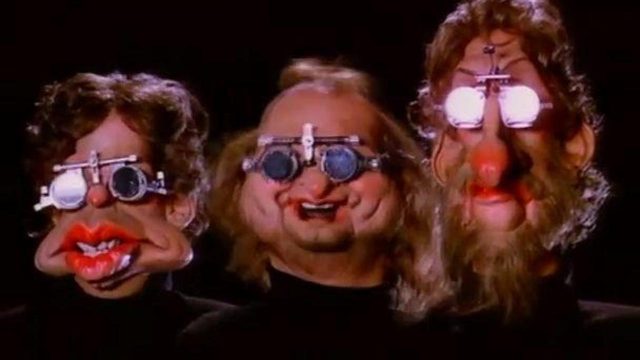Genesis: Land of Confusion (1986) dir. John Lloyd & Jim Yukich
Once there was a time when a big name in entertainment somehow became president and there was a lot of fear that a nuclear situation would develop… look, this is a feature about brevity so the idea is I’m comparing our current times to the Reagan era. Moving on.
While the anxiety over Reagan’s time didn’t produce the breadth of work that the Vietnam War era did, it at least let some 80s kids stay up past their bedtimes and share a pastime with their parents – Cold War nightmares.
Dear me, that whole thing is terrifying. Sorry about that.
I don’t try to translate all the images and references – my attempt would look about the same as Rembert Browne’s on Grantland. Rather I just soak in the horrorshow. If there were a trainwreck on the left side of the road and this video on the other, I’d tell my passenger to sit back so I could see. It’s the visual equivalent of a canker sore, something I can’t help but revisit and then wonder why I cause myself such agony.
Shorts delivered in the form of music videos allow for experimentation to reach a much wider audience than “pure” experimental films by themselves. Particularly in the 80s when the form flourished, there were stop-motion experiments, early computer animation, and even just pure rip-offs of classic experimental films.
Music has long been a part of films, of course, even before synchronized sound. And while there are plenty of examples of experimental films that use no music, the presence of music does not make an experimental film a music video. The music video allows general audiences to give experimental film a pass because of their two distinguishing features: 1) The length will (generally) be the length of the song, usually less than four minutes. 2) The pacing and tone will be dictated to some degree by the song. Outside of those guidelines – and those are huge guidelines by experimental standards – you can be as abstract or as literal as you wish.
The music video never went away after its 80s heyday, but it did become endangered for a while in the early 2000s when cable stations like MTV, BET and VH1 discovered reality programming and before internet speeds allowed for easy video streaming. Now music videos have a similar “disappearing middle class” issue as feature films, where millions are spent on videos to promote a handful of known stars and most others scrape together increasingly modest budgets. The apparent gap in resources may be defining feature of music videos of the 2010s in the way emerging video technologies were the hallmark of the 80s.
As for “Land of Confusion,” even separated from its references by a few decades there’s an appealing synthesis between music, lyrics and images, with the lyrics serving as a jumping-off point for the puppet antics, suggesting a narrative without strictly enforcing it. I imagine this is what the news looks like for children, with recurring faces that are recognizable but unreal. Where understanding is just the other side of the story you’re seeing and it frightens you. The television shows absurd things that you assumed the grownups must understand.

